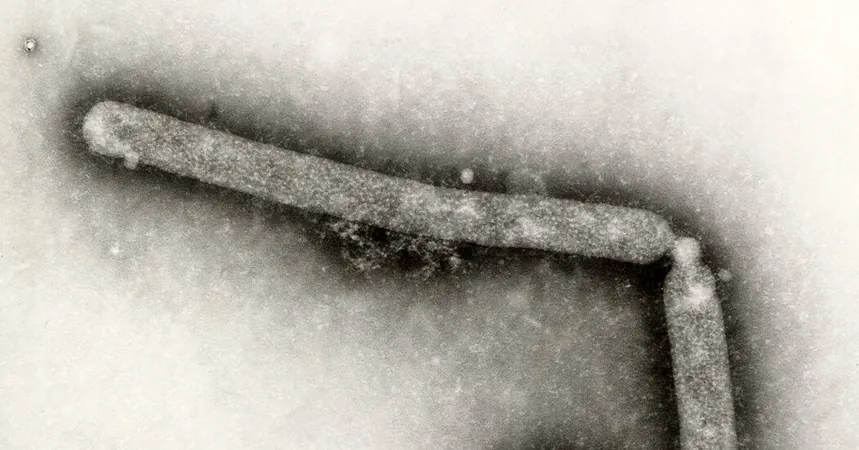
Alarm Bells Ring as First U.S. Bird Flu Death Emerges from Louisiana
2025-01-06
Author: Chun
Alarm Bells Ring as First U.S. Bird Flu Death Emerges from Louisiana
In a troubling development, Louisiana health officials confirmed the first death from bird flu in the United States, raising alarms about the potential implications for public health. The patient, an individual over 65 with underlying health conditions, succumbed to the severe H5N1 avian influenza after being exposed to a backyard flock and wild birds.
Despite this tragic case, officials emphasize that there is currently no evidence suggesting that the virus is spreading from person to person within the country. Louisiana remains vigilant, with health authorities reporting no other identified cases. Patients are encouraged to consume pasteurized dairy products, which are safe from contamination.
Dr. Diego Diel, a virologist from Cornell University, reassured the public that the risk level remains low but urged continued caution. “It is crucial that individuals avoid contact with sick animals, poultry, or wild birds,” he said. This outbreak is particularly concerning as new mutations in the virus might increase its ability to infect humans.
Interestingly, recent reports indicated that the Louisiana patient carried specific mutations that could facilitate human infection. These mutations were absent in virus samples from the infected flock, indicating that they may have developed during the patient’s illness. A similar mutation was found in a 13-year-old Canadian girl’s sample, highlighting a potential pattern of evolution in the virus, though she has since recovered.
Both individuals were infected with a strain of the virus commonly found in wild birds, which is distinct from the strain that recently affected dairy cattle. This raises concerns among experts about the virus’s capacity for mutation and its risk to public health. Dr. James Lawler from the University of Nebraska's Global Center for Health Security warned that as long as the virus circulates widely, especially in humans and other mammals, the risk of mutation grows, posing a threat to everyone.
The threat is intensified this flu season, as there is concern about the possibility of co-infections. A simultaneous infection of H5N1 and seasonal influenza in a single individual could provide a breeding ground for the virus to acquire the necessary mutations to spread efficiently among humans.
H5N1 has been a persistent presence in wild bird populations and has recently affected dairy cattle, leading to outbreaks across 16 states. California declared a public health emergency in December as the outbreak worsened, affecting over 900 herds.
According to the Centers for Disease Control and Prevention (CDC), at least 66 people have contracted H5N1 in the U.S. this year, primarily among agricultural workers in contact with infected livestock. While most cases have reported mild symptoms like conjunctivitis and respiratory issues, there have been nearly 500 global fatalities from H5N1 in the past two decades, predominantly in Southeast Asia.
The Louisiana patient had been hospitalized for weeks, but the state has yet to release further details, citing patient confidentiality laws. Notably, prior to this year, only one human infection was recorded in the U.S.—a poultry worker in Colorado in 2022.
Experts unanimously warn against consuming raw milk from potentially infected cattle, as it may carry high levels of the virus, which could lead to serious public health implications. Though no human infections have been directly linked to raw milk, cases of cats dying from consuming contaminated milk have emerged in several states.
This alarming case in Louisiana serves as a stark reminder of the ongoing risk that H5N1 poses and the necessity for heightened vigilance. Stay tuned as we continue to report on this evolving health crisis!


 Brasil (PT)
Brasil (PT)
 Canada (EN)
Canada (EN)
 Chile (ES)
Chile (ES)
 Česko (CS)
Česko (CS)
 대한민국 (KO)
대한민국 (KO)
 España (ES)
España (ES)
 France (FR)
France (FR)
 Hong Kong (EN)
Hong Kong (EN)
 Italia (IT)
Italia (IT)
 日本 (JA)
日本 (JA)
 Magyarország (HU)
Magyarország (HU)
 Norge (NO)
Norge (NO)
 Polska (PL)
Polska (PL)
 Schweiz (DE)
Schweiz (DE)
 Singapore (EN)
Singapore (EN)
 Sverige (SV)
Sverige (SV)
 Suomi (FI)
Suomi (FI)
 Türkiye (TR)
Türkiye (TR)
 الإمارات العربية المتحدة (AR)
الإمارات العربية المتحدة (AR)